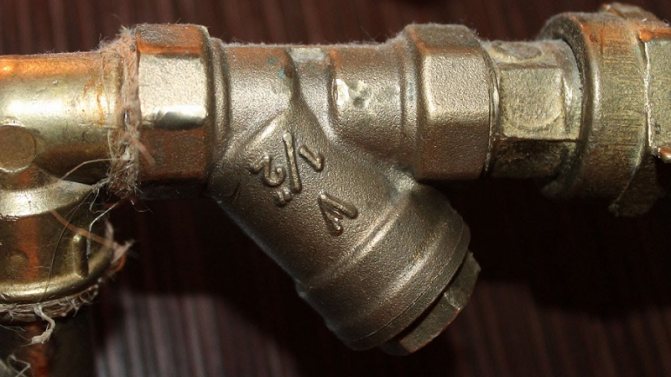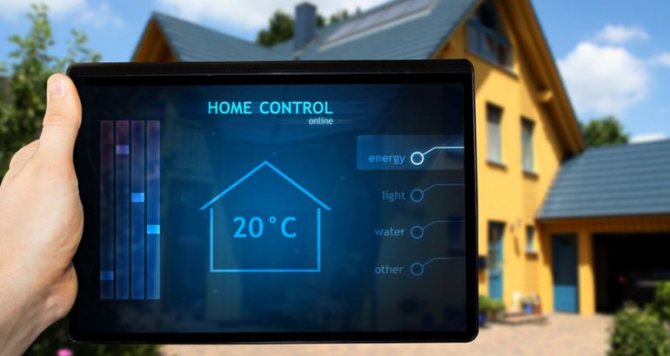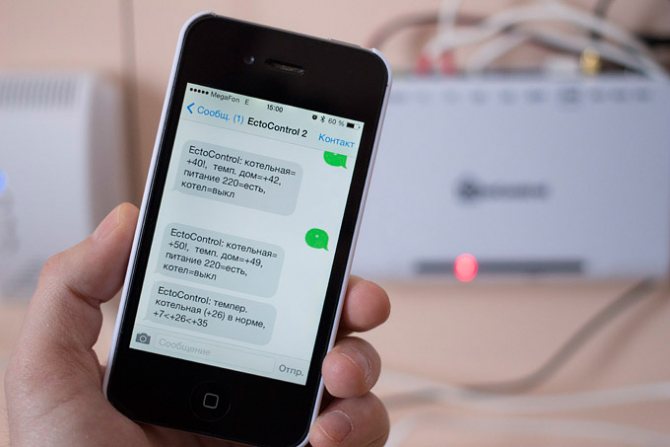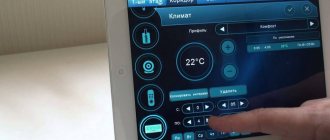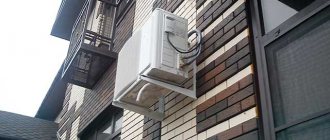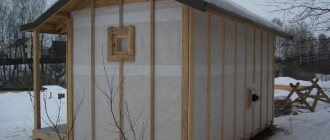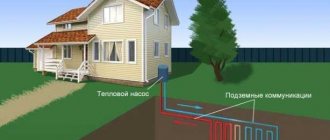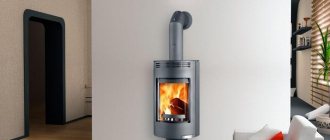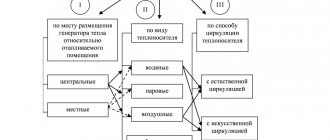Almost every one of us is familiar with the technical innovations that the modern world offers. More often we intersect with them at home, in urban new buildings, but nothing prevents us from building a “Smart Home” in the country, regardless of whether it is an expensive mansion in a cottage village or a small house in a summer cottage cooperative. Naturally, the level of comfort will depend on the initial scale of the dacha and the budget for such systems, but you can always start not from grandiose projects, but act differently - follow the path of the most necessary.
Today, intelligent systems in the country help in many ways. They can be housed in a house or involved in plant growth, work on the correct functioning of the pool or with suburban lighting. Let's talk in more detail about where this automation can be applied and decide how much it is necessary in this or that case.
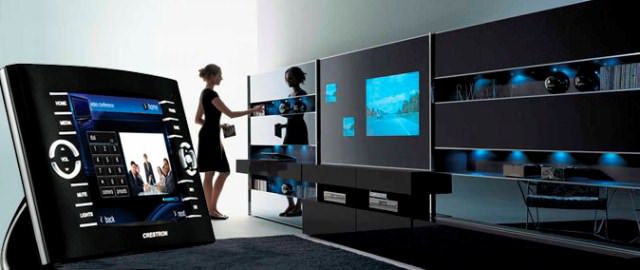
We start assembling the system for remote switching on of electrical appliances via the Internet
- Install the free Z-wave Home Mate software on your smartphone or tablet.
It can be downloaded for Apple mobile devices at itunes.apple.com, and for Android devices at play.google.com. For Android tablet owners, the Z-wave Home Mate version is suitable, for smartphone owners - Z-wave Home Mate (Phone).
- Carefully read the instructions for the mobile app, Z-Wave controller and relay.
Instructions in Russian can be downloaded here:
It is more convenient to print these documents in advance so as not to be read from the smartphone screen - you need your mobile device to make settings.
- Connect the Z-Wave controller to your WiFi router.
The procedure is simple. In short, launch the mobile application, scan the QR code on the back of the controller with a smartphone camera and enter the factory password and username specified in the instructions. Then go to the device list screen and click on the controller name. For more details see. And it will help you to cope with the task even faster.
Important! After connecting, be sure to change the factory password of the Z-Wave controller. Password change is a standard security procedure for any smart device connected to the Internet
- Connect the relay to the controller.
To do this, select the “Include device” item in the application: for 60 seconds, the controller will enter the search mode for a new device. Then plug the new relay into a power outlet. The controller will detect it and add it to the network. The relay name will be displayed in the general list of connected devices. Try turning the relay on / off via the app.
Important! When adding a new device for the first time, the controller should be no more than 1 m away from it.After successfully adding to the network, the relay can be connected to any outlet that is no more than 30 m away from the controller
- Connect the heaters to smart relays and try to control them through the app.
Happened? Your system is ready to go! Now, leaving the house to the dacha, just start the program on your smartphone and turn on the heating remotely. In the app, you can program sockets to start and stop automatically at a specified time.
Smart sockets can be used to connect not only heaters, but also other household electrical appliances. And most importantly, the Switching Lite kit will become the foundation of your future smart home. Unlike devices using GSM mobile network and SMS-messages for control, the system based on Z-Wave technology is easy to expand.Just buy sensors for motion, temperature, opening and closing doors and windows, water leaks, alarms, etc. Moreover, you do not have to purchase a SIM card for each module, as required by GSM products. And the convenient and intuitive Z-Wave Home Mate app will help you manage your smart home without any extra hassle.
District heating control
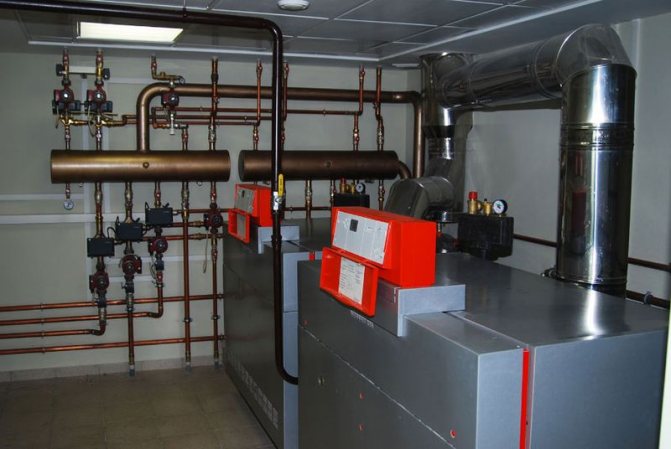
Central heating uses electronic and mechanical thermostats and thermostats
Unlike installing a controller and relay in a private house, when equipping district heating for an apartment building, the system will be different. In this case, it is necessary to connect sensors to each pipe, and the controller must provide autonomous heating, and not remote control. But via GSM or Ethernet, the control unit can transmit statistical data or information about the state of the heating.
In a centralized heating system, modules with specific relays, sensors and thermostats are used. There is no need for Ethernet protocols and remote control - automation according to preset parameters plays an important role in DSP. The complexity of the installation of this equipment does not allow you to independently engage in its installation - this should be done by a specialized specialist.
How to ensure heating control in the Smart Home system
If you try to implement a “smart home” heating system with your own hands, it is quite possible to achieve positive effects without even combining heating systems under the general control of a computer.
Heating elements and heating units can be equipped with controllers associated with indoor temperature sensors. After that, the heating devices can be set to the operating mode (the order of switching on and off by time or when the temperature reaches a certain value).
The disadvantages of this solution are as follows:
- each such device will have to be configured separately;
- he will not coordinate his work with other systems at home;
- each individual system will not react to temperature changes from the outside, since it simply does not have such data.
A more effective solution is to create a space heating system under the control of a single control unit, which can be set to a general operating mode (taking into account the peculiarities of functioning for each group of heating devices separately).
For both simple and combined heating systems, it is a good idea to define the temperature zones by setting separate heating parameters for each of them. A smart home whose heating is configured in this way will heat the living quarters more strongly, give heat to the garage with less activity, and make sure that the temperature in the wine cellar does not rise.
Weather-compensated heating control
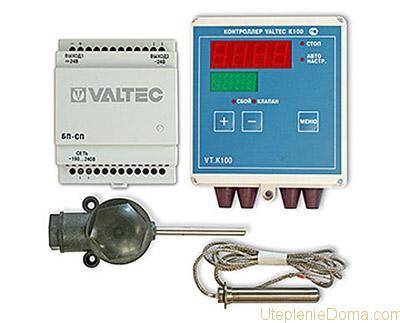

An important link in the "smart home" system is the weather-dependent regulator.
A weather-compensated heating controller is one of the key elements for creating comfort with a smart home. An external temperature sensor allows you to correlate the temperature outside the room and the inside, and then, according to a given curve of this ratio, determine the operating mode without human intervention.
The weather-dependent heating controller will control the heating of the room, responding to changes in the weather outside: evenly increase the temperature when it gets cold, or stop heating if it is hot outside.
Since the weather heating controller reacts to the outside temperature, it can maintain heat according to a preset program and prevent excessive consumption. Smart heating of a country house will lower the temperature when there is no need to heat the premises (if the owners have left).
Integrated heating control in the "Smart Home" system
An integrated approach involves heating control in combination with monitoring the operation of the ventilation system and the water supply system.This allows you to fully maintain a certain climate in the house, taking into account the air humidity and temperature indicators in different rooms.
You can set various operating scenarios for all systems controlled by the "Smart Home", and implement a notification function if any of the subsystems fails.
In addition, you can use mobile communication to give a command to the system. Smart heating of a country house will start preparing living quarters for receiving guests on such a signal in advance.
Integrated management of heating, ventilation, water supply and electricity in the “Smart Home” system as a result gives and increases energy efficiency (the crisis of energy resources dictates solutions in household construction).
Smart heating system strategy
There is no need to once again talk about how controversial the issue of heating residential premises is. It is directly related to the cost of energy consumption and these costs significantly burden the family budget.
Therefore, the smart heating strategy is a really important and worthwhile topic to not only consider but also try to implement.
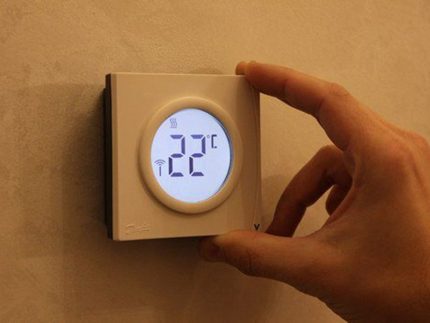

It is enough to set the temperature parameter on a separate thermostat and "smart" heating will do all the necessary work to provide the owner of the apartment (private house) with comfortable conditions
If you apply the smart home strategy to your heating system in its entirety, there is every chance of significant cost savings. Accurate consumption control and rational distribution of the heat resource will contribute to savings.
The smart home strategy in relation to the heating system has been calculated and tested in practice. The result promises the massiveness of this approach.
Remote control of complex heating systems
The Polish company Tech Controllers is gaining an increasing share in this market segment, producing a wide range of controllers with remote control capabilities.
By themselves, Tech controllers are multifunctional devices that are the main, basic part of the system, which can remotely control almost any complexity of heating systems using additional modules. There are a lot of possibilities, therefore, using an example, we will only consider the possibilities for remote control.
Installation example of Tech Controllers equipment
The photo used for editing:
1. Controller Tech ST-409n is a multifunctional device designed to control a central heating system, providing:
• interaction with three wired room regulators
• interaction with a wireless room thermostat
• smooth control of three mixing valves
• control of the DHW pump
• return temperature protection
• weather-compensated control and weekly programming
• the ability to connect the ST-65 GSM module for remote heating control from a GSM smartphone
• the ability to connect the ST-505 module, which allows remote control of the boiler via the Internet.
• the ability to control two additional valves using additional modules ST-61v4 or ST-431 N
• Ability to control additional equipment such as garage doors, lighting or sprinkler, etc.
Different Tech modules can be used for remote control, it all depends on the specific needs of the owner. For example:
2. Tech Wi-Fi RS module, which allows:
• remotely control the operation of the boiler via the Internet
• view the parameters of all devices in the heating system
• edit all parameters of the main controller
• view the history of alarms and parameter changes
• assign an unlimited number of passwords (for different access levels - menus, events, statistics)
• change the set temperature on the room regulator
• notify owner of alarms by email
3. Ethernet module Tech ST-505
• remote control of the boiler operation via the Internet
• viewing the parameters of all devices of the heating system
• the ability to edit all parameters of the main controller
• viewing the history of alarms and parameter changes
• the ability to assign an unlimited number of passwords (for different access levels - menus, events, statistics)
• changing the set temperature on the room regulator
• alarm notification by email of alarm
The module interacts with the Tech controller wirelessly and allows remote control of the boiler operation from a GSM mobile phone.
• SMS message about each deviation from the preset boiler operation parameters,
• the module sends on demand a message with information about the current temperature on all active sensors. After entering the authorization code, it is also possible to remotely change the set temperatures.
• by sms and by phone (incoming call) with a message about a malfunction of the heating device.
What if the heating system is so individual that none of the above solutions can fully meet the needs of its owner for its control?
There are no hopeless situations! Most often, the customer himself simply does not understand (and should not!) All the capabilities of modern remote heating control systems. It is really difficult for an unprepared person to understand all this abundance of devices offered on the market, which are completely different from each other in functionality, price, and, of course, quality. And installers, often, simply have no idea about the possibilities for controlling heating systems - their task is to mount the system, but how often you will run around the house (or into the boiler room) and turn various valves to ensure constant thermal comfort, they do not care ... Our specialists more than once had to almost completely redo the "creations" of such craftsmen, and this, believe me, costs a lot of money. Miser pays twice. Contact us, we will advise you for free, and, if necessary, we will install a remote heating control system, we will help with the selection of high-quality equipment at an affordable price.
You will be satisfied working with us!
Remote control of the heating system
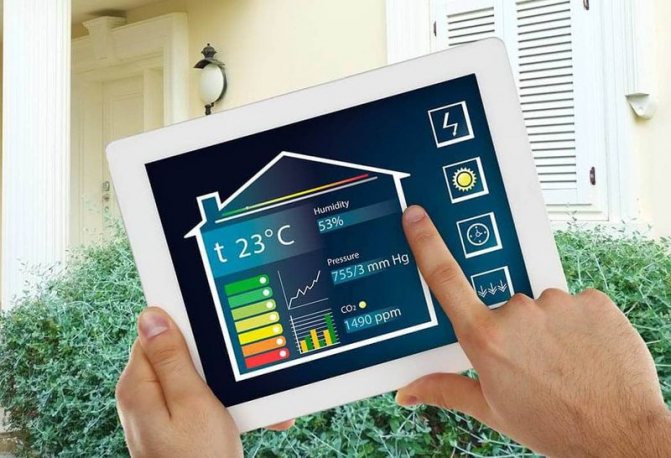

The ability to remotely adjust the parameters of the heating network is the main advantage of the complex
All controllers of heating systems included in the "smart home" category are divided into two categories: local and zonal.
Local-type control units are systems that control the climate inside the house as a whole, regulating the operation of the entire heating system, including "warm floors", radiators, boiler and zone heaters.
Zone control units are devices that control the operation of a certain element of the heating system, for example, only "warm floors" or "boiler and radiators". In both cases, the controllers can be operated remotely via GSM, Ethernet, Wi-Fi or other modules.
Via GSM block
The units working with the GSM module have the ability to configure and change parameters using SMS messages. This is convenient for setting up without the Internet, but it is considered a disadvantage, due to the demands on the quality of the cellular network.
The controller of this category works with the help of GSM networks, therefore it must be used in accordance with the peculiarity of the region, and it can be installed only at a certain height.
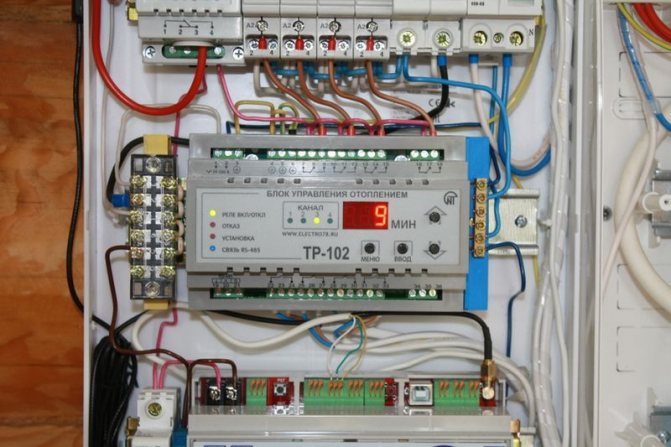

Domestic heating system control units are no worse than Western ones, but they look less attractive
GSM controllers for “smart home” are being superseded by Ethernet modules in the market. Due to the complexity in configuration, local controllers are relevant with the ability to connect to the Internet.Zone modules can be used with GSM protocol (for example, regulation and control of hot water supplied to radiators). Such controllers have a simple device, simple configuration (via SMS), convenient control and a notification system.
Models of the following types are suitable for zone control:
- GSM-Thermometer "Telemetrika" - easy setup, 4 relays for control, convenient mobile application;
- GSM-Thermometer "Warm House 22" - display, several operating modes, which are switched by buttons or SMS, thermometers are connected by telephone cable;
- TS2 GSM v6 - complex setup, but great functionality, the ability to connect to the device through the application, a convenient display;
- Climate ZONT-H1 GSM - inconvenient interface, setting parameters through the manufacturer's website, working with 1 relay.
Most modern controllers have built-in GPS and Ethernet modules, which allows you to choose convenient control in certain conditions. The connection is carried out through circuits that are installed inside the heating system, and are connected to the complex itself through a "relay".
Ethernet
In the “smart home” system, heating can be controlled via an Internet connection. This requires that the installed control unit has the appropriate module and supports an Ethernet connection. Unlike GSM controllers, they allow several users to work through the software at once.
The list of gadgets available for connection depends on the software of the control unit and its firmware, as well as the model, most can work with smartphones, PCs, laptops and tablets. Another advantage is that the parameter setting in such controllers is available anywhere in the world where there is Internet access.
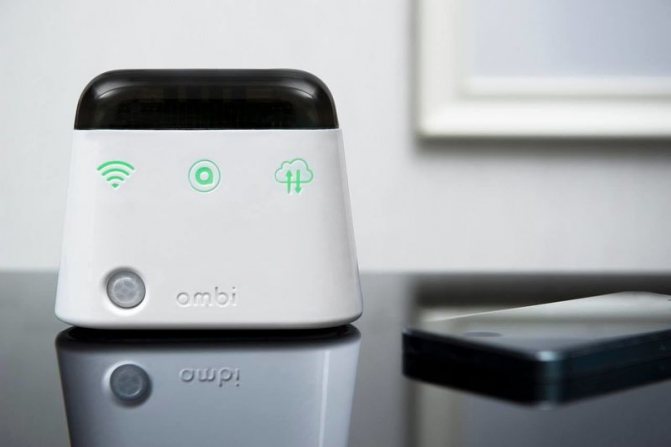

Most modern programmers and controllers have built-in both GSM and Ethernet protocols.
Unlike programmers and GSM controllers, control units with the ability to connect via the Internet have the following advantages:
- There is no limit on the number of users.
- You can customize the settings by connecting to a network anywhere in the world.
- Convenient interface.
- The ability to integrate with voice assistants "Google Assistant" or "Alice".
- You can configure such controllers without the help of a specialist.
Since there is no reference to a number, identification of the owner plays an important role in such blocks. Most people choose a PIN code as protection, but you can use voice identification, fingerprint or FaceID.
In domestic units that work remotely via the Internet, an Arduino module is usually used, which can be adapted into any circuit for remote control. But you can use other models with an Internet relay.
Remote control of the boiler room using mobile GSM
But what if there is no wired Internet in a country house? How can the heating be controlled in this case?
It's very simple - with the help of a special GSM module and, of course, a mobile phone. In fact, the GSM module plays the role of your personal assistant - you called it, gave the command, for example, to heat it hotter by a certain time in advance - and the whole family will come to a warm and cozy home. Or, on the contrary, you forgot to turn down the boiler power when leaving for work in the morning - no question, you can do this directly from work, via the Internet or directly from your smartphone, while you are still getting to work
The GSM module is a compact device with its own SIM-card of any operator (it is important that it provides reliable signal reception in a given area), which allows you to control the indoor climate from any phone (satellite, mobile or fixed connection), tablet or PC
Depending on the settings made, your phone will receive either short SMS notifications with various information and instructions on changing the settings of the heating boiler, or you will receive phone calls with various information about the operation of the heating system. A special mobile application is installed on the phone (there are versions for Android, and for iOs, and for Windows Phone), which allows you to directly remotely control almost all the parameters of the heating boiler.
The GSM heating control module is essentially a computer docked with external sensors and has the ability to change the operating modes of the heating system. Naturally, the module must be in the area of reliable reception of mobile operators.
The GSM module for the heating boiler GSM-Climate ZONT H-1 is a very interesting solution offered by the Russian company Micro Line, which specially manufactured this device for the company Evan, which produces heating boilers. Immediately, we note that Zont H-1 GSM is suitable not only for Evan boilers, but, in fact, for any heat generators that have appropriate terminals for connecting a room thermostat!
GSM modules in their work, as a rule, use cloud services, so you will always have the opportunity to control or change the parameters of the heating system via the Internet (that is, without sending control SMS or phone calls) using a tablet, personal computer or smartphone, by going to the website of the module manufacturer using your username and password.
GSM heating control module can operate in several modes:
- automatic, when, according to signals from installed sensors, the controller maintains the specified modes according to a specified program;
- SMS heating control, when the heating system is controlled by sending SMS. In this case, when new data arrives, for example, about the room temperature, the controller accepts them for execution and begins to support them in automatic mode;
- warning, by sending alarm messages about the current state of the house (gas leak, breakthrough of the water supply system, etc.);
- remote control of other devices connected to the GSM module (watering, lighting, alarm, etc.).
GSM - heating control allows remotely:
- receive reports on the room temperature;
- receive notifications about the current state of heating equipment;
- change the operating mode of the system by raising or lowering the temperature, including separately in each room.
Heating control is not limited to these functions. In principle, any heating system can be turned into a remote one. To do this, it must have an automatic mode of operation, and a special GSM controller must be connected to it for heating control and communication with the subscriber.
General landscape management
Everything outside the house is always under our strict attention. But there are many inconveniences that we do not notice in everyday life. If you think about them, then modernization and connection to the general system of some landscape novelties will greatly facilitate our work, save free time:
- It's not difficult, but why go to the same garage every time to turn on the general lighting in the garden, if this can be done from a touch tablet;
- Turning on the pump in the fountain or changing the water in its bowl is now also optional manually, everything can happen automatically;
- Again about watering the lawn - everything is tied to one automatic platform;
- And you can also install and remove canopies over young plants by pressing only one button, drain the drainage, turn on the spread of fertilizers.
Heating control system elements
The heating control unit is a collection of elements combined into a single circuit. Their selection becomes key to ensure the efficiency of the system. Items may differ in characteristics. The main indicator of their effectiveness is the possibility of forming a multilateral communication between the control unit, the owner and the heating elements.
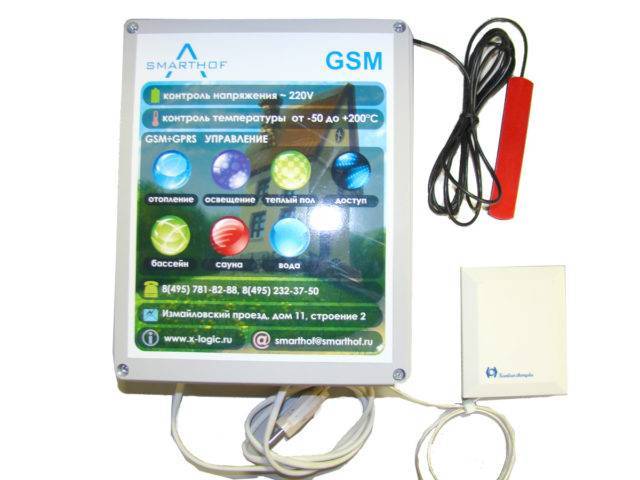

The basis of the system is a special electronic unit with 1 or more slots (sockets) for installing ordinary SIM - cards of cellular communication
Standard complete set of elements of the GSM coordination system with heating:
- connecting wires;
- several temperature meters;
- GSM controller;
- leak detector;
- electronic key scanner;
- access control mechanism;
- antenna for reception and transmission of GSM signal;
- accumulator battery;
- ethernet adapter that provides interaction with other elements;
- pads for connecting to the boiler;
What are the capabilities of remote heating control systems
- normal operation, when the set temperature is maintained throughout the house;
- zone mode, when in different rooms there can be an individual temperature;
- prevention of defrosting of the heating system (freezing of pipes) during the cold season, when you are away from your country house or summer cottage;
- the possibility of turning on the boiler in advance, for example, you need to warm up a country house when you are going to visit it on weekends or holidays;
- always be aware of the operation of your autonomous heating and, if necessary, carry out its diagnostics;
- time mode, in which at different times during the day in the house its own thermal mode can be maintained with a significant reduction in material costs for fuel, for example, you can adjust the boiler to low power (respectively, to low fuel consumption), going to work or on business, and turn on normal mode before returning.
Remote heating control implies that any of these modes, as well as specific temperature values in rooms, are changed using a mobile connection, or heating is controlled via the Internet. This approach is part of the ideology of creating a “smart home”, which entails the further development of all engineering systems of the house in order to ensure ease of use and the creation of the most comfortable living conditions.
Which heating system can be remotely controlled?
In country houses and cottages, two-pipe systems with forced circulation of the coolant are currently most often used: the circulation pump pumps the coolant throughout the heating system, which, thanks to the distributor comb, can be supplied to each heating device. In such systems, as a rule, a safety block is used heating system to protect it from destruction in unforeseen situations, for example, in the event of an increase in pressure above the permissible level. It is also necessary to have additional equipment to control the operation of the heating system: sensors, special valves and devices for regulating the flow of the coolant, and it is also necessary to combine various devices into an information net
Comments.
| Andrey 03/12/12 93 it is necessary to control heating elements with a capacity of 3 kW. tell me how to connect triacs to BM8036 through standard outputs. |
| Egor 03/12/12 95 Download the instruction, the link to which is at the very beginning of the article, this instruction shows all the necessary schemes. Do not forget the fact that triacs with such a power must be installed on radiators. |
| Andrey 03/12/12 96 I can't understand this instruction. the instructions say: For BM8036, which has no triacs on the board, you need to connect power triacs to the XS5-XS12 outputs. in Appendix 1 BM8036: The electrical circuit of the triacs is. but in Appendix 2 NB8036 they are just not there. |
| Egor 03/12/12 97 So you have NM8036 or BM8036? Appendix 1 is BM8036 and Appendix 2 is NM8036. Their output stages are obviously different. What do you have in the output stages? Check the specification if the board is not clear. How many channels? |
| Andrey 12.03.12 98 I plan to buy BM8036. while I understand everything. do you have triacs in the output stages in the NB8036? the instructions say that there are no triacs on the BM8036 board, although they are on the diagram. this is what misleads me. |
| Egor 12.03.12 99 Yes, there is apparently a mistake in the instructions. You should read: "For NM8036, which has no triacs on the board ...".NM really does not have them either in the circuit or on the board. As far as BM is concerned, I do not presume to judge what is there and what is not. I am working with the NM8036 Timer-Thermostat. |
| Evgeniy 03/29/12 146 Good afternoon !!! I can't figure out how to connect the NM4411 to the NM8036, what should I connect to what? If it is possible schematically to the mail, otherwise these photos do not show any connections at all !!! |
| Egor 03/29/12 147 The article shows the controller contacts to which the load channels are connected (to enlarge, click on the picture). These pins must be connected to the NM4411 inputs. Each NM4411 has 4 load channels, respectively: 4 inputs. I am using all 12 channels of the controller, so I have 3 NM4411 units. |
| Eugene 03/29/12 148 NM4411 has contact X6 - common or ground, and with NM8036, which contact to take for the bundle? It's just that I'm very far from radio engineering and even more so from reading circuits !!! Thank you very much for the clear answers !!! |
| Egor 03/29/12 149 Common, ground, minus the power supply, GND - all this is the same wire. My common NM4411 is connected to the minus of the power supply, because it is the same for all consumers. |
| Evgeniy 03/29/12 150 Thank you very much !!! |
| Dmitry 02/04/14 626 Could you give a layout of the printed circuit board that you have under the NM8036 to display all 12 control channels |
| Egor 04.02.14 627 Board drawing https://www.goandsee.ru/_files/plata.jpg Board size 140 x 96 mm. |
| Dmitry 02/04/14 629 Thank you very much |
Pros and cons of heating control system Smart home
Heating control using a smart home allows you to achieve the following:
- the climate in the house or in any chosen room will exactly correspond to the owner's feeling of comfort, in accordance with the program of operation of the heating devices chosen by him;
- automated control of the heating system can significantly reduce energy consumption;
- intelligent control of household subsystems at home will allow them to be monitored remotely and not worry about possible breakdowns (the computer will react to a malfunction).
The disadvantage of such technologies is still availability due to the rather high cost of equipment and installation of the system.
Spending a couple of weekends in the winter at the dacha - what could be better if you want to take a break from the city noise and crowds? And to come to a country house, warmed up in advance to a comfortable temperature, and even more so.
We have already written about why it is advantageous to use a starter for remote heating of a summer cottage with control via a smartphone or tablet. Now let's talk about how to install it yourself. Don't worry: you don't need the help of an electrician, no installation tools, no wires, or special technical knowledge. If you can program, say, a microwave oven with a snooze timer, then you can easily cope with the installation of the Switching Lite kit.
Electric heaters up to 3 kW can be connected to the included smart plug-on relay. They are quite enough to warm up the rooms of a medium-sized country house in two to three hours. Are you ready to try it? Begin!
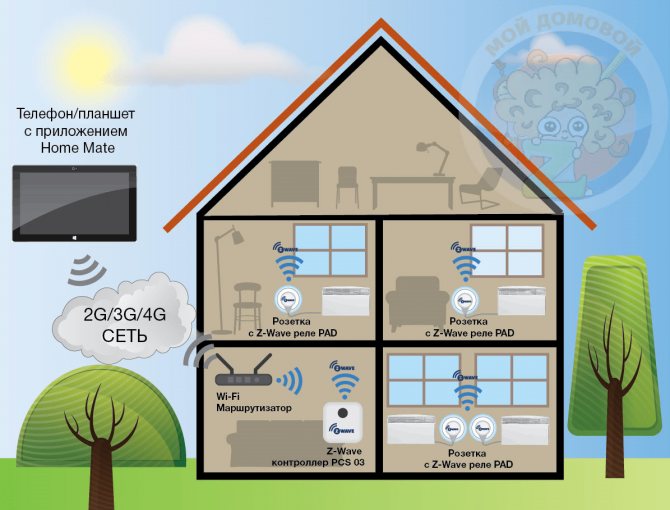

Control scheme for heating devices via the Internet in a country house
Heating controller selection
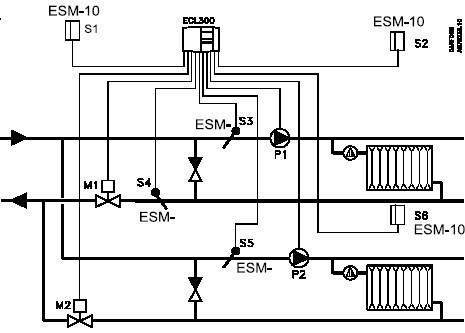

Example of controller wiring diagram
When do you need to install a heating controller? First of all, this device is necessary in case of frequent absences from the house or apartment of residents. By connecting the electronic unit to external temperature sensors (outdoors and indoors) and the boiler control terminals, you can use the built-in software to set up an automatic change in the intensity of the burner operation.
How to choose the optimal controllers for heating systems? The easiest option is to consult a specialist. But it is difficult to find one at this time, as this product is relatively new. Therefore, it is recommended that you first independently study the main selection parameters:
- When comparing a controller for a heating boiler, make sure that the installed equipment has the ability to connect to the control unit. Most often, the boiler is characterized by one-stage or two-stage external control. This applies only to gas models - matching with solid fuel is impossible;
- The number of components to manage.For a Honeywell heating controller, this value can be up to 15, depending on the specific model;
- The presence of a GPS unit. As mentioned above - this function makes it possible to remotely control the heating;
- Frequency of software updates. The modern controller of heating and hot water supply systems TRM 32 can be connected directly to the computer. You can always find the latest software version on the manufacturer's website.
An additional function is to regulate the operation of the components according to the set heating schedule. This possibility is provided in the Aries heating controller.
You should also pay attention to the accuracy of the measurements. In professional models, this indicator should not exceed ± 0.01 of the scale
Integrated management of "Smart home"
This type of control implies an integrated approach to ensure comfortable conditions in the rooms. The following main indicators are monitored:
- proper ventilation in every room and in the house as a whole;
- maintaining a certain level of humidity;
- operation of the water supply system;
- other indicators that are connected to the control panel at the request of the client.
Comprehensive data analysis allows you to customize the program in order to improve the sleep of home owners and their guests. For this, the intensity of the heating devices is adjusted to lower the temperature in the bedrooms by several degrees, thereby having a beneficial effect on the well-being of people and guaranteeing good rest and recovery of the body.
The iT500 is lacking No problem Salus iT600 can do anything and more
If you lack the functionality of the iT500 to control only two heating zones, then our website presents a more functional multi-zone (there are wired and wireless versions) Salus iT 600 Smart Home system. Well, something, and its capabilities for remote control of heating (and not only!) Will be enough for even the most demanding consumer!
iT 600 Smart Home combines the ability to control warm water floors, remote control of heating using thermostats, single switching at the “smart home system” level, changing the temperature in each room using a smartphone with Internet access, monitoring and control of any electrical devices in home, connecting sensors for opening windows and doors and many other functionalities. The system far outstripped not only its competitors in the field of remote heating control, but also set the trend in the field of automation and dispatching of engineering systems for many years to come!
Attention! The new Salus iT600 Smart Home product line is already on sale!
Now you can not only remotely control the heating, but also guard the house and control electrical appliances!
Buy heating control system SALUS iT600
Now you have the opportunity to buy Salus iT600 Smart Home - a new line of automation for the Smart Home!
This is the same full-fledged system for remote heating control via the iT600 Internet plus additional features:
- application of the universal Internet gateway Smart Home UGE600, which now supports up to 100 wireless devices of the ZigBee network and is used to replace last year's version of the Salus G30 gateway.
- control and management of various electrical appliances. connected to smart sockets Salus SPE600 with the ability to meter the consumed electricity
- connection and control of security alarms using wireless sensors for opening doors or windows Salus OS600 Door Sensor
- managing your system is now even more convenient. thanks to the new Salus Smart Home app for smartphones on iOS and Android, the interface and registration of devices have become much easier and more intuitive!
All system components are wireless devices operating in the modern ZigBee home network standard, now you can create separate groups of devices that work in one bundle and which can be assigned individual tasks.
In the future, the company's engineers intend to expand the capabilities of the smart home control system, but now you can buy Salus iT600 Smart Home, starting with the bare essentials, and build your Smart home at a very attractive price!
And what about the owners of outdated heating systems?
Tech WiFi 8S is one of the newest and most functional models of thermostats from the Polish company Tech Controllers (Polish version of the name Tech Sterowniki), on the basis of which you can build a multi-zone radiator heating control system for your home. For example, in a country house or in a country house, the heating system was installed many years ago. Naturally, a distributor comb was not provided, there are no three-way mixing valves, there is, in principle, no possibility to control something. Until recently, the only way out of this situation was to install mechanical thermal heads on radiators. Such a solution has the right to exist, but, firstly, the accuracy of temperature control is several degrees, and secondly, you need to adjust these very thermal heads on each radiator separately, in the morning and in the evening. Troubled and uncomfortable. Fortunately, electric thermal heads with high measurement accuracy have appeared on the market. Tech Controllers went even further and offers you a whole system that controls battery-powered thermoelectric servos over your home Wi-Fi network in accordance with preset settings. And now even the owners of outdated heating systems have an opportunity for a comfortable stay!
Tech WiFi 8S can control the temperature in 8 rooms, each of which can have up to 6 thermal actuators! In addition to controlling thermoelectric drives, the controller can also control the boiler: when the set temperature is reached in all rooms, it will turn off the boiler using a "dry contact".
Buy heating control system TECH WiFi-8S
Tips for selecting components and setting up system management
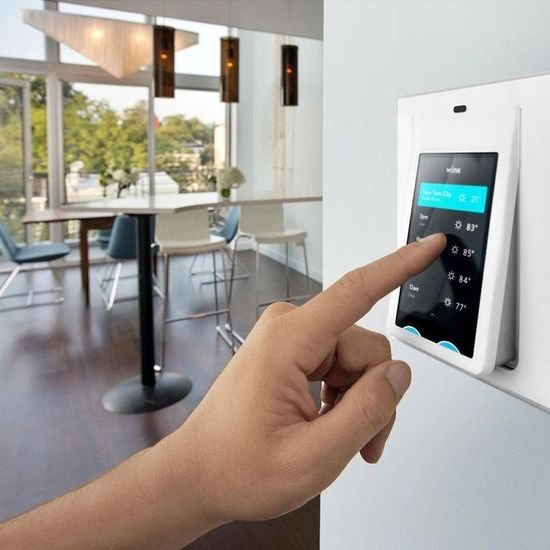

The right decision would be to order a turnkey "smart home" installation
If it is decided to integrate a control unit into the heating system, which will allow you to remotely configure its operation, then it is important which model will be purchased. From those on the market, units of both zonal and local types are relevant. You can buy pre-assembled control units or purchase modules with relays that are configured as programmers through the official software. Ready-to-install controllers with display, regulators and a set of modules have a higher price than modules with relays.


Athom Homey is the best model on the market, but it also has the highest price
It is important to immediately decide which protocols it will work with - not all devices can be integrated using Z-Wave or ZigBee standards. If it is not possible to understand the program code, then you should buy exclusively ready-to-use, assembled "smart home" units. They work in various standards, but they are all ready to use right out of the box:
- Fibaro Home Center 2 - compatible with Google Assistant, has an Ethernet connection, works via the Z-Wave standard;
- RaZberry is an inexpensive device with limited functionality, works through the HomeKit standard, can be configured via a PC;
- VeraPlus is a multifunctional controller that works with most standards (including Z-Wave and ZigBee), user-friendly interface, easy configuration via computer and smartphone;
- Athom Homey is the best controller in terms of functionality, compatible with all standards (including integration with "Alice"), simple configuration, support for all necessary protocols, but a very expensive model.
The range of boards with executive relays is much larger. These include the well-known "Arduino" module, the program code of which is in open sources and can be customized in accordance with the user's requests. A set of such modules can be combined into a single system, where remote control of both heating and other components of the "smart home" system will be carried out, to which any electrical devices can be connected.
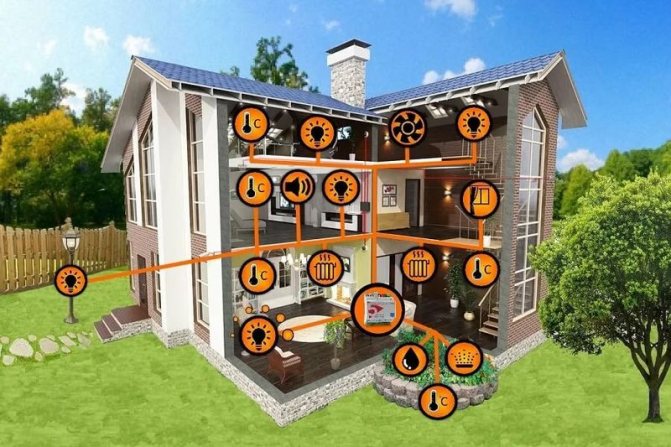

The "smart home" system can connect not only heating, but also ventilation, water supply, lighting and other elements of a modern home, powered by electricity
Programmers are fundamentally different - these are systems equipped with thermostats, thermometers, leakage and humidity sensors by default. They use from 1 to 16 circuits, which allows for spot control of heating.
Remote control systems are not relevant for use in district heating. In the boiler rooms of apartment buildings, automation devices are used that control the temperature and turn off a certain pipeline, or the entire boiler, at the required rates. Programmers are suitable for these purposes, in the parameters you can connect SMS notifications, but control is carried out using knobs, buttons and a display.
How is the heating system Smart home
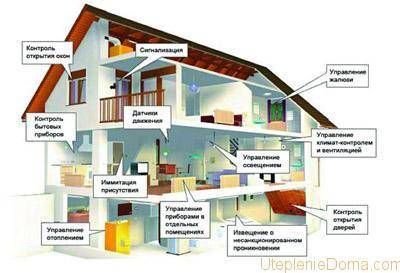

An approximate diagram of the "smart home" system
The thermal conductivity of walls and ceilings, the quality of the windows, the presence of drafts and air humidity, the type of heating system and the way heat is supplied all affect the indoor climate.
Modern heating systems can be functionally different: these are classic radiators, warm floors, etc. In country houses, individual boilers are installed for heating and providing hot water, while a boiler can be used in an apartment.
All this can be controlled by a single system, which is called "smart home". It is a control computer unit associated with home appliances and indoor and outdoor temperature sensor systems. In accordance with the information of the sensors and the set mode, such a system is capable of lowering or increasing the temperature in the room. In addition, it can regulate the amount of hot water ready for use in the boiler.
Additional advantages of automatic systems in the country
We think that it remains to give a few more very necessary examples, and you will definitely be sure of all the advantages of the proposed management system for the entire dacha economy.
At this stage, consider the management of the greenhouse:
- Soil heating;
- Drip irrigation or sprinkling;
- Air humidity regulation;
- Temperature modes day / night or hourly;
- Lighting, for example, in cloudy weather or when a longer daylight is needed for young plants;
- The same fertilizers, airing, spraying;
- Preventive measures to control diseases or pests.
A little about the farm yard, where they often keep small animals and birds:
- Heating of premises;
- Ventilation and complete air replacement;
- Changing the litter, installing a new one;
- Feed and water supply;
- Lighting, daylight regulation for different breeds of birds.
Heating control devices
Programmers and thermostats
The key parts of a heating control system are thermostats and programmers. They are electronic devices, in some modifications equipped with a control panel, which helps to control the functioning of the boiler. In addition, such a device allows you to synchronously change the indicators in two connected components.
In addition, an additional function of the programmers is adjustment via SMS from a cell phone or commands transmitted over the Internet.
A suitable modification of this device can be selected by a set of basic characteristics, which may include:
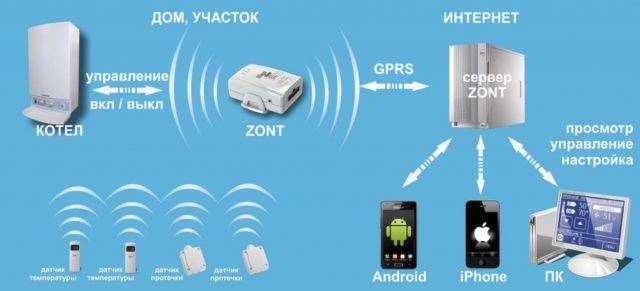

Management via the Internet is carried out in the same way, only through a different communication channel between the homeowner and the electronic unit in the house.
- remote communication between components using radio transmitters;
- the operation of radiators (depending on the settings) can be in a comfortable, normal or economic mode;
- the number of connected circuits can be increased by connecting additional modules;
- heating control by mobile phone;
- data transfer via SMS, etc.
These functional features make the presented elements quite convenient and in demand.
Zone devices
Such heating control elements are installed directly on radiators and boilers. In this case, the regulation by the system is carried out via the Internet connection.These devices are represented by electronic thermostats. They are able to change the temperature of the water in each individual battery or system as a whole. The differences between these thermostats are ease of installation and affordable price. At the same time, the complexity of the system device is reduced, especially since they do not require a separate control cabinet. Zone devices allow the use of several thermostats that are connected to one control unit.
Remote heating control modules
The function of remote control of the heating network can be provided by special modules included in the package with shut-off and control valves and programmers.
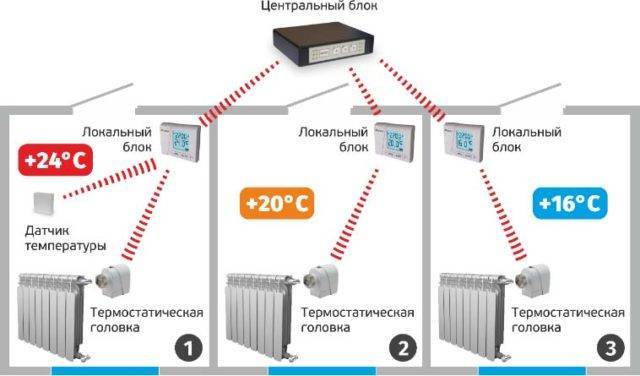

The number of additional device functions is limited by the number of connected sensors and executive relays of the electronic heating control unit itself
Smart heat supply options
Actually, the principle is obvious - building a heating circuit diagram taking into account the introduction of control sensors, as well as actuators at the points of energy distribution.
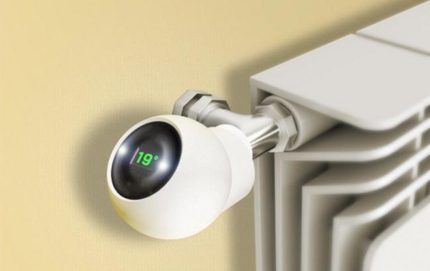

The power distribution point is temperature control on a single heater. In aggregate, there may be several such points within the heating circuit.
Control sensors and mechanics, in turn, are connected to the lines of a controller equipped with control software.
In principle, everything is simple, given the development of monitoring and control technologies through controllers.
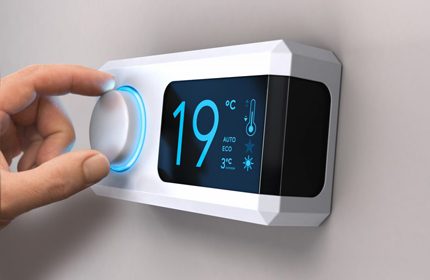

A controller variant from a series of digital equipment designed to equip a smart home. Such devices are developed in different designs and architectural forms, different in technical capabilities.
Considering the possible options for schemes, of course, one should take into account their application, depending on the type of housing and its location.
Traditionally, there are two options:
- Urban sector.
- Country sector.
The heat supply systems for these two options differ somewhat, because in urban conditions, district heating is more and more often given priority.
The suburban sector is characterized by an autonomous heating system. Therefore, the “smart” heating solution for these two options may differ.
Solution # 1 - for a city apartment
Let's consider a possible scheme of "smart" heat supply in relation to the residential urban sector. Most of the city's infrastructure is now partially automated.
As a rule, there are coolant control systems in each individual apartment building. What remains to be done by the owner of an individual apartment?
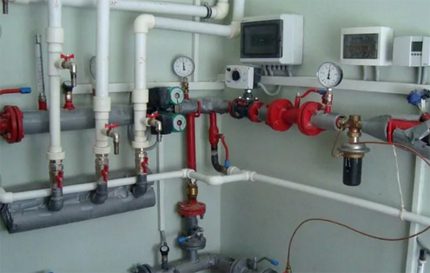

The heating unit of one of the city apartment buildings, where the principle of automatic adjustment of the coolant supply to the house circuit has been established, depending on the temperature conditions (weather) on the street
Inside one specific apartment of an apartment building, you can use an automated control system taking into account heat consumption. However, in this case, the general (house) scheme of the distribution of the coolant matters.
If this scheme is of a sequential nature of switching on devices, individual metering of energy consumption cannot be carried out, as well as a separate adjustment.
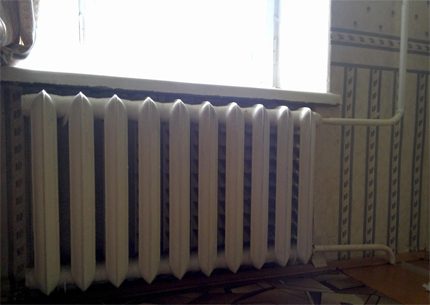

With this option of turning on a heating device in the circuit of an apartment building, it is almost impossible to install a "smart" circuit. True, there is an option if you turn on the jumper pipe and mount the automation after the jumper
The scheme of parallel connection of heating devices allows you to control consumption and keep records. This is done by installing temperature sensors, regulators and a controller.
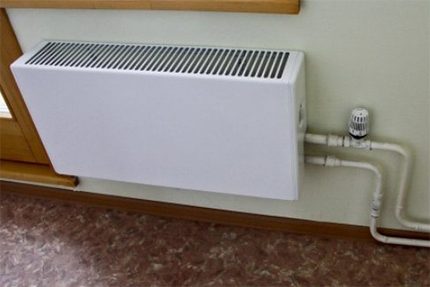

An example of simple automation in a city apartment by turning on a thermostat on the heating medium supply line.A parallel system for connecting the house circuit is used here, so the scheme is easier to implement
Temperature sensors are installed directly on the supply and return water lines, plus an indoor temperature sensor is required.
Control valves are installed on the return pipe of heating devices. All these devices are combined with a control controller.
Solution # 2 - for a country house
The solution for a suburban or urban private autonomous home is characterized by unlimited possibilities.
An autonomous private economy, as a rule, operates on its own heat supply system, for example, from a boiler. In this option, automation is easier in terms of independence, but from a technical point of view, it is somewhat more difficult.
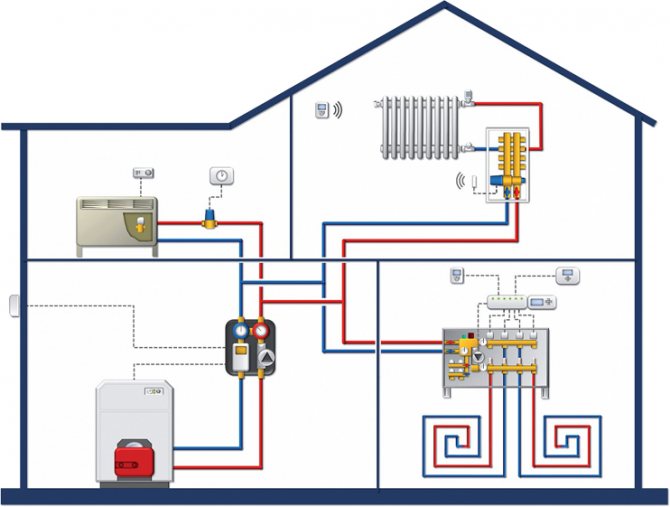

Block diagram of heating automation (one of the options), where along with external heating devices (batteries), a "warm" floor is also used. Two options for battery automation, one wireless
The complexity is due to the application of automation and control not only to home heating devices, but also directly to the heat source - the boiler.
The proposed designs of modern boiler equipment support full automation, including:
- fuel loading;
- combustion intensity;
- circulation of the carrier;
- temperature limits;
- active timer.
If an apparatus of just such a configuration is used, it is enough to coordinate the heating control system of the smart home inside the room with the boiler equipment controller. In another case, if there are design features of the boiler, it will be necessary to automate the boiler installation from the beginning.
Then, for example, the set temperature value on the sensor located inside the room will be an additional reference point for the boiler controller.
Based on this guideline, fuel consumption, combustion intensity and other operations of boiler equipment will be carried out.
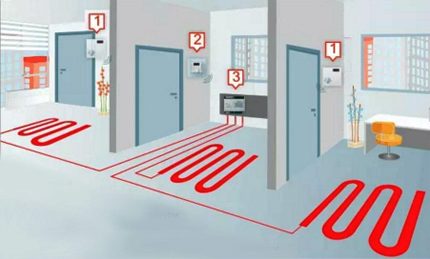

Separate automation of the thermal background for each room of a residential building (example of a diagram): 1, 2 - individual control panel (controller) with individual valves and temperature sensors; 3 - controller for control of "warm" floors
However, it is permissible to create different temperature conditions in each separate room, provided that one room is adequately sealed from another.
In this version, the regulation of the heat flow is additionally carried out with the help of individual thermostats and regulators that control the flow of the coolant through the devices (batteries, floor heating system).

